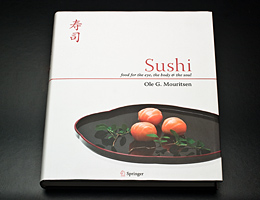-

- Mouritsen, Ole G.: Sushi: Food for the Eye, the Body & the Soul
Springer; New York
1st English ed., 2009, 360pp, 429 illus., 397 in color., Hardcover
ISBN: 978-1-4419-0617-5
At the over-matured sushi
the Master
is full of regret
- Matsuo Bashō (1644-1694)
4. Storage & conservation
Fish and shellfish decompose very quickly after they die. For this reason they must be eaten while they are absolutely fresh or, alternatively, be deep frozen or preserved in order to increase their keeping time and conserve the healthy nutritional elements in them. One can employ a number of different methods of preservation, for example, cooking, salting, drying, smoking, marinating, and fermentation. In all cases, the taste and texture are affected.
The term tsukemono includes a wide range of wholly or partly preserved products made from vegetables and fruits, employing techniques of salting, souring, or fermentation. We would call them pickles. The pickling produces new flavours and preserves the nutritional value. Tsukemono are eaten at virtually every Japanese meal. Pickled ginger (gari), an important condiment with sushi and sashimi, is a typical example of tsukemono.